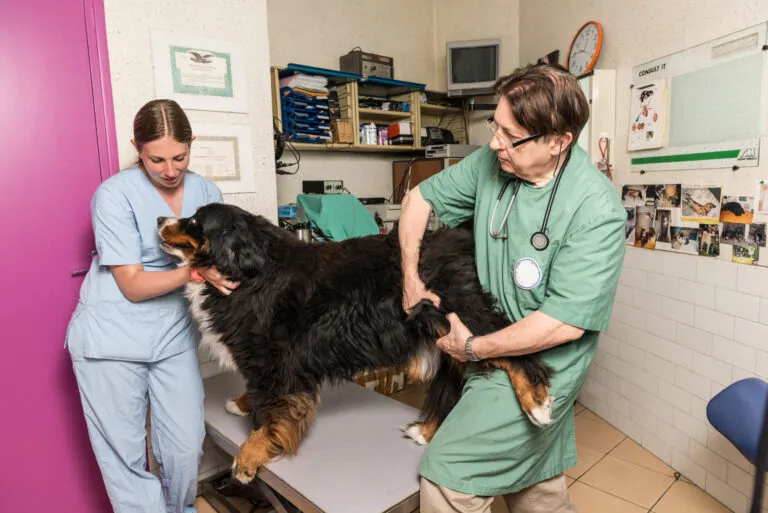Hip dysplasia (HD) affecting dogs is a genetically caused joint development disorder. External influences like environmental factors, housing and diet can also have a negative effect on joint development.
Hip dysplasia predominantly affects medium- to large-sized breeds, with smaller breeds less frequently affected. It often emerges with breeds like the Golden and Labrador Retriever, Bernese Mountain Dog, Boxer, Rottweiler, German Shepherd and St Bernard, rarely with Greyhounds or Borzois. Dogs aren’t born with hip dysplasia but have the genetic predisposition for it. At the age of around 12 months, affected puppies develop dislocated hips (subluxation). The femoral head isn’t fixed firmly enough in the hip socket and moves around instead. Changes resulting from this like hip joint arthrosis emerge from the age of four months. Many dogs with a mild form of hip dysplasia often only show symptoms such as lameness in old age. Factors such as a heavy body weight or quick growth can intensify HD, which is why a healthy diet with a moderate calorie and adapted mineral content is so important in the puppy phase. An excessively high provision of energy or minerals like calcium can have a negative influence on hip dysplasia.
Symptoms of hip dysplasia
Symptoms of hip dysplasia can vary in intensity depending on the dog’s age, extent of the illness and limitation of hip joint function. With young dogs of around four to eight months in age, a rolling, waddling gait and low urge for exercise may attract your attention. As it develops, dogs show lameness, have problems standing up and become less mobile on their back legs. The musculature of the back legs decreases, since affected dogs protect their back legs due to the pain. Equally, muscles surrounding the hip joint may hurt with muscle contractions.
Diagnosing hip dysplasia
Hip dysplasia is diagnosed via X-ray examination. In order to optimally assess a hip X-ray, the hip dysplasia image should always be taken in a standardised setting when the dog is sedated. This is necessary in order for the muscles to be relaxed and the dog not to suffer any pain when being positioned for the X-ray. The images allow the vet to assess the severity of the hip dysplasia and changes to the hip joint. A crucial assessment criterion is the Norberg angle, which is determined with two lines between the centres of both femoral heads and the front edge of the socket. The angle should be more than 105° for a dog without HD. The following alterations are also signs of hip dysplasia: the hip joint socket, femoral head or both are flattened, meaning there is no guaranteed optimal position for the femoral head in the hip socket. Also, a misalignment of the femoral neck or head is frequently observed. Signs of arthrosis such as lesions on the front and back socket edge and the crossover from the femoral neck to head are often already visible. When it comes to choosing animals for breeding, certain criteria to prepare the X-ray examinations and assess the results are necessary. A further X-ray examination with straddled thighs and raised ankles (known as a frog-leg examination) is also required for some breeds in some countries so that changes to the femur bones and socket edges can be better assessed. Animals for breeding are classified in five categories according to the specifications of the FCI (Fédération Cynologique Internationale):
- A = no indication of hip dysplasia
- B = marginal case
- C = minor hip dysplasia
- D = moderate hip dysplasia
- E = severe hip dysplasia
Along with X-rays, the results of clinical examinations and symptoms are also crucial for treating dogs.
Treatment
There are various options available for treating hip dysplasia, although none heal it. Forms of treatment can alleviate pain and inflammation, delay the onset of arthrosis and improve mobility and joint mechanics. The chosen form of treatment depends on many different factors like the severity of the symptoms, X-ray results and the dog’s breed, age and weight, as well as the owner. There is a difference between conservative and operative treatment for hip dysplasia. Reduced strain and support for the joints are paramount with conservative treatment. Weight loss is required in cases of obesity so that the joints are not put under additional strain due to excessive body weight. Dietary supplements like omega-3 fatty acids, green-lipped mussels, chondroitin and glucosamine are able to support the joints and improve symptoms. Controlled movement on soft surfaces to protect the joints and building up the muscles with swimming, for instance, is advisable to avoid excess strain. In contrast, abrupt movements like those involved with playing, jumping and turning are to be avoided due to the heavy strain on the joint surfaces, capsules and surrounding tissue. In addition, physiotherapeutic measures can be used to alleviate pain and inflammation and to relieve muscle tension. Medication such as anti-inflammatories and pain relief are used, sometimes in combination. There are a range of options are available for surgical treatment. When making a choice, it is necessary to differentiate between young dogs with no joint alterations and adult dogs whose joints have already undergone changes.
Hip dysplasia prognosis
Prognosis depends of the severity and emerging symptoms of hip dysplasia. A combination of treatment methods can improve symptoms with many dogs and allow them to go as long a period as possible with few or no complaints. There is no cure for hip dysplasia; it is only possible to alleviate symptoms and slow down changes to the joints.
Preventing hip dysplasia
Since hip dysplasia is genetic, it can only be prevented by strict breeding measures. Only HD-free dogs should be allowed to be deployed for breeding. However, dog owners can help to prevent severe hip dysplasia to a certain extent. It is recommended not to put puppies under too much strain, particularly with large breeds. As well, calorie-rich food should be avoided and the food should contain a species-appropriate proportion of minerals and vitamins.
